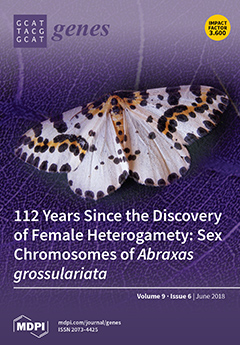In animals, sexual differences between males and females are usually determined by sex chromosomes. Alternatively, sex may also be determined by vertically transmitted intracellular microbial endosymbionts. The best known cytoplasmic sex manipulative endosymbiont is
Wolbachia which can, for instance, feminize genetic males into
[...] Read more.
In animals, sexual differences between males and females are usually determined by sex chromosomes. Alternatively, sex may also be determined by vertically transmitted intracellular microbial endosymbionts. The best known cytoplasmic sex manipulative endosymbiont is
Wolbachia which can, for instance, feminize genetic males into phenotypic females in the terrestrial isopod
Armadillidium vulgare. However, the molecular genetic basis of cytoplasmic sex determination is unknown. To identify candidate genes of feminization induced by
Wolbachia strain
wVulC from
A. vulgare, we sequenced the genome of
Wolbachia strain
wCon from
Cylisticus convexus, the most closely related known
Wolbachia strain to
wVulC that does not induce feminization, and compared it to the
wVulC genome. Then, we performed gene expression profiling of the 216 resulting
wVulC candidate genes throughout host developmental stages in
A. vulgare and the heterologous host
C. convexus. We identified a set of 35 feminization candidate genes showing differential expression during host sexual development. Interestingly, 27 of the 35 genes are present in the
f element, which is a piece of a feminizing
Wolbachia genome horizontally transferred into the nuclear genome of
A. vulgare and involved in female sex determination. Assuming that the molecular genetic basis of feminization by
Wolbachia and the
f element is the same, the 27 genes are candidates for acting as master sex determination genes in
A. vulgare females carrying the
f element.
Full article






